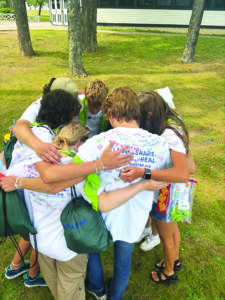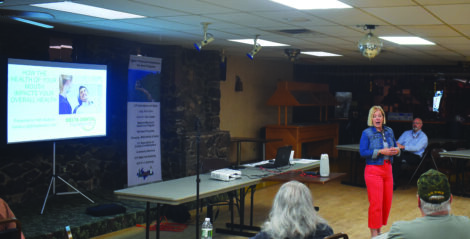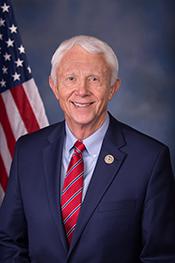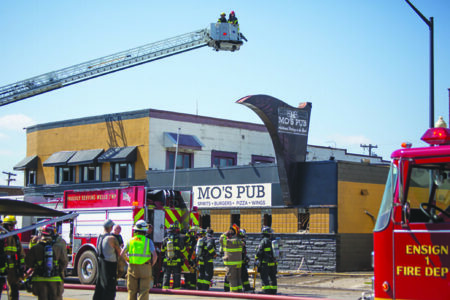Capturing the past
New sculptures unveiled

Kent Kraft for the Gazette Artist Kasey Koski describes how she created her "Oil Man" art piece to the audience.
HANCOCK – A new installation by an artist with Copper Country roots was unveiled Wednesday. Keweenaw National Historical Park (KNHP), the Park’s Advisory Commission (KNHPAC), Isle Royale and Keweenaw Parks Association (IRKPA), the Quincy Mine Hoist Association, along with artist Kasey Koski held a press conference and art unveiling at the Quincy Smelter. Three new sculptures by Koski are in place at the smelter along M-26, as well as two more sculptures at the Quincy Shaft Rock House along US-41.
Wyndeth Davis, KNHP superintendent, greeted those gathered at the smelter for the art reveal. She said it was an honor to work with Koski again to further their efforts to return people to the landscape. Sean Gohman, KNHPAC executive director, gave a brief history of the Quincy Smelter. The Commission actually owns the property and works collaboratively with the Quincy Mine Hoist Association to provide tours of the smelter for the public. Gohman said the smelter is, “a national, world, and of course local historically significant site.” While guided tours are available through the smelter, he said the location was “missing passive interpretive signage to help visitors better understand the infrastructure.”
Gohman said “Certainly, there are no people working here now. Thankfully … Kasey Koski is returning them here.”
Koski addressed the crowd, discussing her work the previous year when she was selected a call for a commissioned artist and created four sculptures that were installed at the dry house ruins across US-41 from the Quincy Shaft Rock House. “Those pieces depicted the miners and their families, so this time we wanted to capture the labor parts of processing copper,” said Koski, describing how the two sites this year were selected for her new art pieces. “It’s been an honor to work with the park to bring people back to the landscape,” she continued, echoing the sentiment of the previous speakers. “Now let’s go see them!”
With that, the crowd walked down a pathway to enter the fenced in Quincy Smelting Works, with hard hats donning the head of every visitor. Once inside the environ of the tall brick buildings, old smoke stacks, and mine tailings, Gohman oriented visitors to the historic workings of the smelter. Two of Koski’s five new art pieces are inside buildings in the smelter, and are only able to be viewed by people on a tour. These pieces are of working men, showing what people used to do inside the walls of these industrial artifacts. Before seeing the men at work, Gohman described the importance of their jobs. “Everything here was run off of coal fueled steam engines, so they were very important. One of the sculptures shows an oil man, keeping the steam engines running smoothly.” As for the second sculpture, the worker can be seen “tapping out a brick to let molten copper out,” something that happened at the end of the refining process.
Koski led the group into the first building to house her oil man sculpture. With the crowd seeing her new artwork for the first time, Koski described the look of the cut metal sculpture. They are designed to rust to a patina which makes a shell on the outside but does not compromise the structural integrity of the metal. “Since these are inside the buildings, I took matters into my own hands and gave them a vinegar bath to hopefully accelerate the rust patina.” This was a conscious decision on Koski’s part because she wants the sculptures to have the same aged, weathered rusty look of the historic equipment all around.
At her second sculpture, Koski was asked how she knew what the workers should look like specific jobs. “We did a Zoom tour of the smelter while I was in Washington,” Koski explained, “and I used source materials like historic photographs and tools that are still laying around to refine the look of the sculptures.”
Beyond those two sculptures, Koski told the audience there was a third at the smelter, and everyone passed it on their way in. Closer to M-26 at the entrance to the smelter is a miner waving in greeting to passing cars. At the Quincy shaft rock house along US-41, another sculpture sits inside the ruins of a boiler house, shoveling coal as workers of the past would. There is also a sculpture she entitled “Quitting Time” in between the shaft rock house itself and US41. Three men are depicted, one the boss looking at a pocket watch and two miners happy to be out of the mine and done with their shift.
“It is really interesting to explain a building in just one figure,” Koski answered in response to another question. “I kind of love the magic that happens, a visitor finding unexpected artwork that explains the purpose of the place.”
This was a sentiment echoed by Davis. “Kasey seemed to understand the challenge and was really able to distill in these figures art that doesn’t just decorate the landscape, but that interprets what happened here,” she said. “We don’t have to put up a sign explaining each piece of work, that would kind of defeat the purpose. They’re open ended enough that I’ve heard visitors from the local area say, ‘This reminds me of my uncle,’ or, ‘This reminds me of my grandfather.’ They’re also specific enough that clearly they belong to the place and the time.”
When asked how these two specific places within the smelter were chosen, Koski said it “was a difficult challenge because I’ve looked at a lot of plans for the site. What are the functions of all of these buildings? Where does the tour go? Learning where the route for the tour is and what they’re actual covering on each tour helped us narrow it down. We’re not just putting people all around the site, but that specifically these places could use a visual aid to the tour. That helped us identify where.”
Reflecting on her collaboration with KNHP and all the other partners, Koski said, “Getting to do this once was fascinating. I was just beside myself last year. The whole time I was here, I was giddy. At the end of last year’s project, to have them say, ‘Well, I don’t think we want anything different, we think we’d like you to continue.’ I thought fantastic!”
Davis hinted at more to come. “We’d love to be able to bring these to more heritage sites and we think the heritage sites would love to see them too. It’s kind of a challenge because you have to find a spot where you’re not decorating, you’re interpreting. They won’t fit just anywhere!”
Gohman was pleased the smelter was able to get Koski’s artwork this year. “This complex was started in 1898, was one of the last ones built by Quincy, and is the last one still standing,” he mentioned. “The commission acquired the smelter to transfer to KNHP in 2013 – 2014, which hasn’t happened, but we are happy to be the stewards and work with our partner, which is Quincy Mine Hoist Association, to put on tours.”
“We’re just slowly but surely trying to make improvements,” he continued, “and increase exposure. This kind of project is increasing that exposure.” The artwork returns people to the landscape and everyone involved is hoping they’ll help bring visitors to the site. If you would like to support this continuing effort, you can contact Gohman at sean_gohman@partner.nps.gov.





